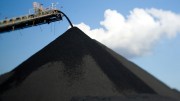Jessica Fung, commodities analyst with BMO Capital Markets, gave the following keynote presentation at Red Cloud’s fourth annual pre-Prospectors & Developers Association of Canada Investor Showcase on Feb. 28 at the Fairmont Royal York Hotel in Toronto. Fung outlined her views on the current market and what she believes is needed for metal prices to recover.
I have been told my views could be interpreted as a little bit bearish right now. I want to be bullish: I’ll say that my life at BMO would be so much easier, if I were very bullish.
What I will say is that we are in a challenging cycle right now, as I think we’ve seen in the last few years. But with every challenge, and every point in the cycle, comes opportunity. And that’s what makes this such an exciting sector and industry. And I’m happy to talk to you about this current cycle.
The title of the presentation is ‘Commodity cycles through a copper lens,’ so first let’s talk about why we are going to look at it through a copper lens — because I know there are a lot of gold guys in the audience.
Copper demand is driven by broad economic growth. It’s used in construction to high-end consumer electronics. And when the biggest consumer of commodities in the world — China — is shifting from a capital-intensive model to one that is driven by consumers, we definitely need to look at a commodity that is leveraged to both. Copper also has pronounced price cycles, especially compared to gold, and these are the cycles that really move the mining equities.
Finally, copper prices are still mostly driven by supply and demand fundamentals, U.S. dollar moves can impact commodity prices in the short-term, and speculators in the market can drive sentiment one way or the other. But at the end of the day, it is still about fundamentals, because a stronger dollar and a weaker copper price, or gold price, is based on the idea that demand weakens, when you have to spend more of your local currency to buy that same tonne or same ounce of metal. And speculators have not taken prices down by 25% — copper prices down by 25% — in the last year, because they thought demand was going to exceed expectations.
There is only one condition required for prices to improve: we need an undersupplied market. I know this is profound. Out of the last 50 years, average annual copper prices rose in 26 out of those 50 years, and out of those 26 years, 23 were in deficit, or immediately following a deficit market. We need to look at what the drivers are behind an undersupplied market.
Historically it is kick-started by a surge in demand growth, usually during an economic recovery, but not always. We had 9.5% demand growth in 1964; 9.1% in 1969; 14.5% in 1976 after the oil crisis; 9% in 1984; and 9% in 2004. These are big numbers.
If we hit 9% demand growth this year, it’s an incremental 2 million tonnes of copper consumed, which is equivalent to doubling annual copper use in the U.S., or quadrupling Germany’s annual demand, or quadrupling Japan’s annual copper demand — and you can see why this level of demand growth can drive copper prices higher.
But I’m going to take you through why I think demand will not be the hero in our current commodity cycle, and if demand is not our hero, then the recovery must be driven by the supply side.
There are two reasons why demand will not save the day. The first is a little thing called quantitative easing (QE), and the second is another little thing, called China.
Over the last 50 years, we’ve had five recessionary periods, and during these periods, copper demand declined, and by ‘declined,’ I mean declined. It’s not slower growth, it’s not weak growth — it’s negative growth. And when demand declines, so does supply, historically. Again, not slowing growth, not weak supply growth, it’s negative supply growth. These cuts in production during previous recessions are the reason why there is a supply gap during a recovery and prices move up.
If we stick with the condition that a price recovery requires an undersupplied market, and that undersupplied markets are kick-started by surge in demand growth followed by a supply gap, that condition was never going to materialize this time around. Why? Because of QE.
Unprecedented easing during the financial crisis effectively pulled forward demand. And so during the 2009 financial crisis, global copper demand did not decline. Demand from the U.S., Europe and Japan declined by double digits because this had been the worst recession since the World Wars. But because of QE, this decline was probably not as bad as it could have been, which is shocking.
At the same time, China’s own US$590-billion stimulus increased their demand by 38%. This is unprecedented demand growth by a key consuming region during a recession. And because demand did not decline, neither did supply. You know all those statistics we hear in copper about 80% supply disruption and 10% supply disruption?
In fact, net copper supply has still grown every year for the last 12 years. And the last time we saw supply decline was in 2002, that was during the recession of the early 2000s.
We’ve got excess capacity that remains in place. Unprecedented easing pulled forward demand, and it means we took away from future growth. How did we pull forward so much demand? Well, we levered up, and we borrowed our way to commodities consumption.
Since 2007, global debt levels have increased by 40% to US$199 trillion. China’s debt quadrupled to US$28 trillion. Debt levels do increase after every recession, and it is generally considered necessary to finance economic growth, and of the previous recessions we also saw global gross domestic product (GDP) growth recover to well over 4%, and to 6% in some cases. And that debt historically drove a relatively strong economic recovery.
In the last five years, we have been unable to grow ourselves out of this debt, and we know this because global debt to GDP has increased from 269% in 2007 to 286%, and there is a real risk that we will not be able to grow ourselves out of this debt.
We have had near zero interest rates for the last six years, and we’ve only achieved just over 3% GDP growth. QE is the first reason why demand will not be the hero, because QE efforts meant we levered up; pulled forward demand, taking away from future growth; and that the demand surge we needed to see historically would not materialize.
Now let’s talk about China. I’m going to start with one of my favourite commodity statistics about China: Within a 12-year period, China grew its annual aluminum consumption to the same level it took the entire rest of the world 112 years to achieve. And that’s the impact of China.
Now let’s rewind for a second. Up to 2000, the U.S. was not only a key consumer but also one of the biggest suppliers of refined copper globally. And the nature of the U.S. is to respond to economic downturns by cutting supply in response to a decline in demand. This has historically driven commodity cycles, and Europe played its part, and to a lesser extent, Japan.
But since 2000, as we know, it’s been all about China. And in 2009, during the financial crisis, the global economy shrank by 2.1% while China’s GDP grew by 9.2%. And as we’ve already said, China’s copper demand surged by 38% during the recession, and China’s refined supply increased by 7%.
Again, this is unprecedented growth during a recession. And so while we can stage a recovery now that would kick-start copper demand growth, Chin
a’s growth has only been slowing, because there was, effectively for them, no slowdown from which to recover. And of course, globally, the supply cuts have not materialized.
China’s actions during the 2009 financial crisis, along with QE pulling demand forward, are the two reasons why demand will probably not pull us out of this rut.
I’m going to explore the theme of China just a bit further, beyond the broad strokes of GDP, because having a view on China’s actions going forward is just as important for demand outlook as is looking backward. We’re going to look at urbanization, fixed assets and health.
First, urbanization. Urbanization is often cited as a saviour of the commodity rut. But when we talk about commodity cycles, this thesis is a little bit misplaced. Intuitively, over the long term, urbanization as a driver of commodities makes sense, but this is a very long-term thesis. According to the UN, urbanization will increase by 54% to 66% by 2050, that’s two and a half billion people moving into cities. This is well and good. But by 2050 we may go through another four commodity cycles. Urbanization is often presented as a straight line, and I think everyone in this room knows that metal demand is not a straight line.
Urbanization and metal demand is not always symbiotic. [Europe has seen] demand growth post-1950 … driven by postwar construction, but urbanization was pretty much already in place. And 50 years later, Europe hit its saturation point and per capita copper consumption is now on the decline, and it’s the same in the U.S., Latin America — highly urbanized now — at the same level as Europe, yet copper consumption remains surprisingly low. Here we’ve got Russia. Demand was obviously significantly impacted during the deep recession after the Soviet era.
For some regions, such as Russia, and at some periods in time, economic growth and politics matter much more than urbanization … India in my view has a much longer-term thesis, possibly a multi-generational thesis. We often get asked if we think India is the new China, and my answer always is: ‘I would never say never, but probably not in the near term. And probably not in this commodity cycle.’ I digress.
Let’s go back to China and urbanization. Urbanization clearly has a driving role in copper demand. China now has five megacities to its credit, cities with a population greater than 10 million people. There are 83 million people that live in these five cities. And further, compared to previous examples, China’s copper demand growth looks like it is progressing in a relatively straight line. If we assume a best-case scenario and China continues along this straight line, I estimate it represents 5% annual copper demand growth over the next five years.
What are the risks to this straight line of copper demand growth? Well, Japan. And it’s not because Japan is a risk to China, but because I often hear of the similarities between China’s growth and that of Japan’s from the 1950s and 1960s. Let’s focus on the last 20 years. China’s copper consumption went from less than one kilo per person in 1995, to 7 kilos per person by 2013. This is a sevenfold increase in copper demand within a single generation.
Japan, in the 1950s and 1960s, followed the same demand trajectory that China is on now, and you can see why the parallels are drawn between these countries. But in Japan, there were stumbles along the way. Despite being on a multi-decade growth path, Japan was not immune to the oil crisis in the 1970s, or the slowdown in the early 1990s. And this is just to show that while China is clearly on a multi-decade growth path, there is a risk that copper demand might stumble along the way. And urbanization as a thesis does little to alleviate the stumbles and recoveries that drive these commodity cycles.
If not urbanization, what should we look at? Let’s look at fixed assets. Fixed assets are a great indicator of metals demand because you need copper, steel, aluminum, zinc, silver and platinum to build buildings, equipment and cars.
Fixed assets are also easy to measure, and the two metrics we’re going to focus on are fixed asset investments and housing starts. In China, fixed assets continue to grow, but GDP now meanders sideways, which means every year it takes more money to generate that 1% of incremental growth, and we are in a relatively low inflationary environment. Housing starts struggled last year, down 10% year-on-year.
Do you remember that quadrupling of Chinese debt to US$28 trillion? An estimated half of China’s loans are linked to real estate. If China wants to control its credit situation, property development is probably not the industry the government would be inclined to stimulate. Which means we may not see the same levels of construction starts as we have in the past.
Let’s say China’s growth is not as strong as we expect, or as we would like — as I would like. Would policymakers be willing or able to provide the same stimulus as during the 2009 financial crisis? From a leverage perspective there is a risk, because China’s debt to GDP ratio is now the same as it is globally, where it sits at 286%
Further, growth at any cost is no longer the mandate. Because the cost, as we now know, is the peoples’ health. I took this [smog-filled] photo a year and a half ago in Shanghai, and I took it because it was a pretty clear day. And I wanted to show that it’s not always smog and a can’t-see-10-feet-in front-of-you type of environment, although we have also been there on days that we couldn’t see the building across the street … health is a serious matter. And everyone has an AQI air quality index app on their phone … we check it every morning before we go to work. The lung cancer mortality rate in China has increased by 450% since 1980. And diabetes in China is now more common than it is in the U.S.
Growth at any cost in China cannot be their mandate, and our view is that a stimulus package similar to that which was released in 2009 is probably pretty unlikely. And any monetary stimulus will be directed to sectors where growth is encouraged: healthcare, education, finance, small businesses or consumer goods.
Now that we’ve looked at demand, and determined that it might not get us to an undersupplied market, the only other option is supply. And the good news is that we actually have an example of where supply response can work. 1994 was a post-recession year, similar to our current post-recession environment. Global GDP growth was 3.1%, not the 4–6% we saw in previous recoveries. Copper demand growth was 5.2%, not the 9% that we saw in previous recoveries. Copper prices improved by 21% that year, because of the supply side. Mine supply declined by 0.1% … negative supply growth — so it is possible.
We’re going to look at a couple of supply scenarios: Proactive supply cuts and allowing supply to naturally slow.
The first involves pro-active supply cuts. We’re going to drive this market into a deficit. Let’s cut mine production, let’s curtail smelting and refining production. We’re going to cut scrap supply to the market. We’re going to remove all this excess capacity, and this is the quickest path to commodity price recovery. And it’s easy for me to say this, because I’m a commodities analyst.
Before you dismiss this idea, which some of you might be inclined to do, let’s take a look at what level of supply cuts we’re talking about.
Just to be clear, we’re going to focus on mine supply. We’re going to assume that there’s sufficient smelting and refining capacity, and all
the copper mine gets processed. We’re going to assume 4 million tonnes of scrap and we’re going to assume this 5% mine supply disruption.
This is just to keep things simple. Here is our base-case supply forecast, and the three demand scenarios:
Four-percent demand growth is our base case … 9% demand growth this year to kick-start, and 1% demand growth as our bear case. We’ve got quite a bit of mine supply coming, but let’s look at each demand scenario, and see how much supply we need to cut.
We’re going to aim for a 150,000-tonne deficit next year.
And here’s our base case: gold/copper demand grows at 4% a year, this is effectively 6% demand growth from China, which is not unreasonable. By 2016, we need 1.4 million tonnes of mine supply cut, which is 5.5% of the global mine supply.
Let me explain that in mining math, 1.4 million tonnes of mine-supply cuts equals one Escondida, or three Antaminas or 10 Batu Hijaus.
Here’s our bold case: We get our 9% demand kick-start this year because all is good in the world. U.S. GDP growth hits 3.5%, maybe 4%; Europe and Japan 1.5%, maybe 2%; let’s say China nudges up a bit; India surprises to the upside. And the good news is we would already be in an undersupplied market this year. Next year we’d only have to cut 500,000 tonnes of mine supply — one-third of an Escondida, one Morenci, one Palabora.
Here’s our bear case. Demand growth at 1% a year. This is effectively zero demand growth from China, so definitely a bear case. By 2016 we need to 2.7 million tonnes of mine supply cut, or 11% of global mine supply.
We’re so good at talking about supply. And we spend plenty of money doing it.
In the last eight years, the top-15 copper miners spent $140 billion dollars on copper projects, and the top-five iron ore miners spent $130 billion on their iron ore projects. The challenge is that we know where prices in the iron ore market have gone: down 67% since its peak in 2011, and down 50% in the last year alone. If we need to see supply cuts, who is going to blink first? I call this the commodity market conundrum.
Here we have a chart of the aluminum sector. Three years of prices well into the cost curve before [three major producers] finally announce supply cuts … we can also look at the nickel sector. We’ve been sitting at the 40th percentile now for well over a year. Not enough blinking going on.
What is so tough about cutting supply? Prices will get better. Everyone thinks someone else will make the move. And then nobody ends up making the move.
In order for prices to get better, we have to protect our profit margins, or we have to optimize mine operations. You guys know about all of this. High-grade, defer maintenance, renegotiate with suppliers, cut project spending. There are a lot of things we can do.
And while we optimize mine operations, we end up with an industry cost profile that is declining. In the silver sector, cash costs are declining, sustaining costs are declining and project capital is getting cut.
For many commodities … China is no different from the rest of the world, and their miners are also making production cost cuts wherever they can.
Another challenge for supply cuts of course is high closure costs. If we move beyond optimizing mine operations and put mines on care and maintenance, we’re spending tens of millions of dollars a year. Or we close a mine — tens of millions to hundreds of millions of dollars. Permanently shutting down an operation before depletion is a major decision, and we are unlikely to see this scenario.
We’ve got the single-asset companies. Now they’re not particularly significant on a global scale, but if you halt your operations, you are effectively shutting your company, so we’re not going to see supply cuts from these guys either.
The most important reason why supply cuts are so challenging is because we are not in a recession. And the only other time we have seen supply cuts, without being in a recession, was in 1994. Again, it is possible, but very, very challenging.
Let’s look at the second supply scenario. We’re going to wait for supply to naturally slow, and then we’ll wait for demand to catch up. From a copper perspective, mine supply growth is pretty challenging. Despite the US$140 billion that has gone into the ground, we’re aware that supply growth has only ever come from greenfield. And existing operations, no matter when they ramped up, in aggregate, have only ever reached a flat production profile.
There are still a few projects that are about to emerge from this pipeline — from this US$140 billion — but the rate of supply growth should slow. And we know that demand should catch up, because China is still on its multi-decade growth trajectory. The question is when.
Let’s look at some market-balance scenarios, but instead of looking at how much supply we need to cut, we’re going to look at how much demand needs to grow, or catch up, to bring us to this undersupplied market.
So here’s our base case mine supply forecast again, and the level of demand required, to take us to a 150,000-tonne deficit in each of the next three years.
To reach a deficit market in 2015, we need global copper demand growth of 7.3% this year. This is effectively 10% demand growth from China. To reach a deficit market in 2016, we need 7.1% demand growth [or two years of China’s demand growing at 10%]. And to reach a deficit market by 2017, we need 5.6% demand growth a year, which is China growing at 8–8.5% a year.
These demand growth scenarios are a pretty daunting proposition, I have to say. Because remember, China’s best case, if they were going in a straight line, is only 5%, not the 10% or the 8.5% that we need to see.
Maybe waiting for supply growth to slow is not enough. We at BMO — again, this is a bearish forecast, and I apologize — but we have a surplus market through 2018. We need to see a recovery that is driven by the supply side.
I suspect we’ll see a combination of these two supply scenarios … at the end of the day, commodity prices will recover, they always do, and I believe that. But it’s difficult to say when it’s going to take place.
Demand will not be the hero for us in this cycle. We need to see a supply response, and a mining industry that is in the driver’s seat. Or as I said in the beginning, there are opportunities at every point in the cycle. And this is why we’re here today.
I’m going to keep an eye on the supply side, and we will all be prepared for the upturn when it comes.





Be the first to comment on "‘Demand will not be the hero in our current commodity cycle’"